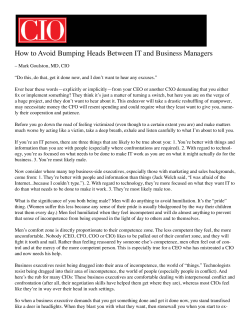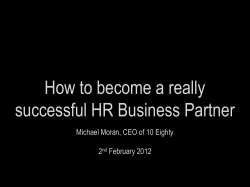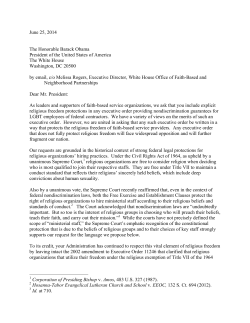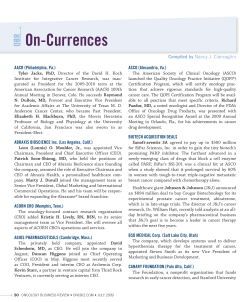
beyond the family tree succession planning for family businesses :
beyond the family tree: succession planning for family businesses about spencer stuart Spencer Stuart is one of the world’s leading executive search consulting firms. Privately held since 1956, Spencer Stuart applies its extensive knowledge of industries, functions and talent to advise select clients — ranging from major multinationals to emerging companies to nonprofit organizations — and address their leadership requirements. Through 51 offices in 27 countries and a broad range of practice groups, Spencer Stuart consultants focus on senior-level executive search, board director appointments, succession planning and in-depth senior executive management assessments. For more information on Spencer Stuart, please visit www.spencerstuart.com. Spencer Stuart consultants build relationships with family business clients that often develop beyond specific search assignments into a more general consultative role, with many family businesses entrusting us with their leadership and succession planning requirements. Planning for the succession of top leaders is critically important for every company, yet it is unfortunately one of the most commonly neglected areas. Family companies, which are typically closely aligned with the founder and sometimes with a family member serving as CEO, generally lack a planned succession. There are either too few or too many potential candidates, which creates confusion and uncertainty for investors, customers, suppliers and employees. Family businesses that are not prepared for an orderly management turnover may be setting the scene for a disruptive battle in the boardroom and, perhaps, the courtroom. How can family companies ensure that they have the right leadership on hand when they need it? Family companies can position themselves for the future by investing in robust leadership development and succession planning processes, adapting succession planning best practices to the unique characteristics of family-owned businesses. Family company leadership should also understand the situations when it may be necessary or appropriate to consider candidates from outside the organization and what to look for in those candidates. For this article, we have drawn on our extensive work with familyowned companies, as well as private equity and public companies, to identify the practices that are associated with effective CEO succession planning and transitions. Considerations include: > The benefit of having a strong board of directors to oversee an objective process for succession planning that includes developing criteria for future leadership, benchmarking internal candidates and identifying skill gaps > The role of independent board directors and the family council in the succession planning process > The need for family business leadership to understand the competitive landscape for talent, the different characteristics of family, private equity and public companies, and the motivations of executives best suited to a family company role > The situations in which family companies are likely to consider recruiting an outside candidate > The experience and leadership characteristics that contribute to the success of a CEO in a family company environment > Ways the board and family can support the new CEO and help him or her succeed 1 company and ceo traits comparison Observations in this chart are based on Spencer Stuart’s knowledge acquired through numerous CEO, COO and board searches over the past 10 years for public, private equity portfolio and family companies. Public Company Private Equity Portfolio Company Family Company CEO Turnover Approximately 4.0 years Approximately 2.5 years Approximately 7 years Independent Directors 80%-90% of board directors are independent Typically, 1 or 2 independent directors Usually, 1 or 2 independent directors Board includes 2 to 3 owners/ equity sponsors and the CEO Board includes 2 to 5 family members CEO and P.E. sponsors develop strategy jointly; chairman is almost always a private equity owner Limits on external CEO’s ability to shape strategy, given family priorities, politics, traditions, ties to community and employee commitments CEO Influence Over Governance and Strategy CEO drives strategy, reports to board “SOX” is time-consuming Especially if also chairman, CEO oversees most governance responsibilities CEO Ownership 1%-2% of outstanding shares, accumulated during the course of tenure 3%-8% of outstanding shares, negotiated upfront and vesting upon private equity’s exit Generally, none Control Over Operations and Team Selection CEO is directly responsible for company operations and performance CEO is responsible for company operations and performance, with ongoing participation by sponsor companies CEO is responsible for operations, but faces limits on his/her ability to make some changes to operations or key personnel Has complete control over who’s on his/her team Community Relations/ Board Sensitivity CEO/boards face scrutiny by press, banks, shareholders and regulators Sponsor firms may force team changes in key roles Little scrutiny by external parties, other than debt holders Family board members may have strong ties to the community More sensitive to external perceptions of the company and family Financials 2 Typically focused on meeting or besting quarterly revenue and earnings targets Usually, highly leveraged Management, board highly focused on meeting short- and mid-range financial targets Less focus on quarterly financial targets succession planning as an ongoing process At any company, one of the most important jobs for the board and CEO is ensuring an uninterrupted flow of capable management. To maintain continuity and prevent last-minute scrambles to identify the next generation of leadership, executives and boards of family businesses must actively plan for succession and, when they must consider recruiting an outsider, take care to find an individual who not only has the appropriate leadership skills, but also is compatible with the organization’s culture. For companies that do it best, succession planning is not just about selecting the next CEO; it is a comprehensive approach to developing management talent throughout the organization. A strong, involved board of directors, particularly one that includes outsiders, can be invaluable in developing an objective process for succession planning that includes identifying criteria for future leadership, benchmarking internal candidates and addressing any skill gaps. Like the board of a public company, the board should establish a committee that is charged with ensuring that succession planning is top of mind. The companies that are most effective at maintaining management continuity plan regularly and systematically for CEO succession. Another important player in the succession planning process is the family council, which represents the family owners who may not be in management or on the board of directors. In well-governed companies, the family council works to achieve family consensus on important company issues, including succession, before they go to the board. The family council becomes a critical element to successful governance in most well-run family businesses. The companies that are most effective at maintaining management continuity plan regularly and systematically for CEO succession. They view succession planning as an ongoing and real-time process; at least once or twice each year, the board and CEO review on a formal basis who would take over in the event of a crisis and consider the current CEO’s timetable for retirement. These discussions should be linked to the strategic planning process. Succession also should be a regular topic for discussion at family council meetings. Succession planning begins by taking into account the company’s strategic objectives — such as a planned expansion into new geographic or product markets — and challenges. The board must identify the skills and expertise the company will need over the next three to five years given its strategy and circumstances. This process should conclude with the development of a detailed position specification outlining the qualities and experiences that are required of the CEO. Often, the family has identified potential internal candidates to succeed the current management. In such 3 cases, the board should evaluate those individuals in relation to the established CEO criteria, benchmarking their skills, abilities and experience against the industry’s best-in-class. By periodically calibrating likely internal candidates against comparable outside leaders, companies can ensure that the best candidate from across the broadest possible universe is chosen. Assessments also are valuable for identifying skill gaps and developmental needs of internal candidates, which then can be addressed. an insider or an outsider? In most family businesses, there is a desire to maintain family leadership of the company and appoint as CEO a family member who has significant experience with the company. Indeed, there is company comparison Observations in this chart are based on Spencer Stuart’s knowledge acquired through numerous CEO, COO and board searches over the past 10 years for public, private equity portfolio and family companies. Public Company P&L Operational Intensity Wall Street Interaction Focus on Cash Flow, Profits Portfolio Diversification Growth Driven Focus on Exit, e.g., Sale or Merger Cultural Compatibility Lifestyle Impact CEO Focus on Operations Versus External Board Control Over Management High 4 Low Private Equity Portfolio Company Family Company typically less risk in appointing an internal candidate who has been vetted through a well-managed succession process than recruiting an executive from the outside. Insiders, especially family members, know how to navigate the organizational, ownership and cultural dynamics of the company, and their strengths and weaknesses are well-known to the board and can be planned for. However, as part of the succession planning process, the board and family council should consider seriously whether to broaden the candidate search to include external candidates. By definition, a search that does not involve external candidates draws on a smaller pool of candidates, which may deprive the company of an opportunity to attract a leader with broader, more diverse experience who is capable of looking at the business in fresh ways or taking the company to a new stage of development not tied to a pre-existing philosophy. time for an outsider? Sometimes the succession planning process reveals that no family member is available or ready to assume control of management or that the company is at a stage when it requires leadership with specific expertise. In these cases, the board and family council must consider whether to recruit management from outside the company. Family companies commonly look outside for CEO candidates in the following situations: > > > > > No insider is ready or has the support of the board because of the early departure of the CEO or because the hoped-for candidate is not meeting expectations The grace period granted to an outsider will provide additional time to put a new strategy in place or add new talent to the team Major change is needed, such as a new strategy or organizational shake-up The company is underperforming versus the competition The company is in the midst of a scandal Family companies also may look for a professional CEO when anticipating the sale of the company in the near future or when, in order to grow, the company requires a CEO or senior executives with experience leading on a larger scale or with more complexity. requirements for the outsider ceo Once a family business has decided to look outside for executive talent, it must find and attract an individual who possesses not only the specific skills and expertise that are needed, but who also is sensitive to the unique issues and dynamics of a family business. The stakes are high for making the right match. While the right external candidate can build on the family’s accomplishments and take the company to the next level, choosing a candidate who is a poor cultural fit can disrupt operations and create confusion and worry among employees. 5 A well thought-through position specification will describe the experience and competencies of the ideal candidate as it relates to the specific business, industry and strategy of the company. In our experience, there are also characteristics common to the outside executives leading family companies. A successful family company leader usually: > > > > > > > > > Has a background that reflects a variety of leadership roles Views himself or herself as the steward of the business and is committed to the company and its stakeholders Uses restraint and diplomacy when communicating with family Displays integrity, honesty and predictability Enhances the family reputation, culture and is community-focused Is able to engage the members of the owning family in their various roles within the organization Cultivates relationships with the board, particularly the chairman Possesses a strong personality, but is able to rein in ego Does not require overt acknowledgement of status and position within the organization Conversely, individuals with an abrasive, take-no-prisoners style of management will rarely be successful in a family company, which typically places significant value on employee and community relationships. While the right external candidate can build on the family’s accomplishments and take the company to the next level, choosing a candidate who is a poor cultural fit can disrupt operations and create confusion and worry among employees. Interestingly, family companies are more attractive to senior-level executives than they may have been a decade ago. In the past, the most experienced leaders preferred to remain in public companies, which were generally better known and perceived to provide better compensation because of the availability of public stock. More recently, private equity portfolio companies have attracted senior executives looking to achieve a large reward for successfully selling a company or taking it public. More and more, however, family companies are viewed favorably by experienced senior executives, who appreciate the freedom from quarterly financial reports and Wall Street scrutiny. Many are attracted to the entrepreneurial nature of family companies, where they can move faster to create new products, improve plant operations or buy a business but don’t have the debt pressure under which many portfolio company leaders must operate. As a result, family company leaders have the flexibility to plan for the long term. 6 helping the outsider succeed Once an executive is hired from the outside, what can the board and family members do to improve the individual’s odds for success? First, support from the departing family member is critical to the successful transfer of leadership. The departing leader should refrain from interfering in operational matters and communicate his or her support for the new leader to both internal and external audiences. The departing leader should avoid doing anything that undermines the authority of the new leader. In addition, the board of directors should define its roles and responsibilities as they relate to the CEO, including who will take the lead in evaluating the CEO’s performance, and set clear expectations about the roles of family members who may be in other management positions. ceo compensation snapshot To illustrate the different compensation characteristics of public, family and private equity portfolio companies, we selected a representative sample of companies under $1 billion in revenue for each category and compared the average base compensation, bonus and trends in equity compensation. Public Company Private Equity Portfolio Company Family Company Base Salary $605,000 $508,000 $497,000 Bonus $321,000 $703,000 $211,000 Equity Stock option or equity awards very common, ranging in value from $70,000 to nearly $15 million 3%-8% ownership, generating a payout, usually at the exit, but under unique circumstances partially before, equal to $3 million to $40 million Typically LTI similar to profit sharing and annual awards range from 50% to 150% of salary, depending on company and individual performance Other Non-equity incentive compensation common Drivers selected to EBITDA Non-equity incentive plans common 7 conclusion In a family company, the most successful leadership transitions occur when the board, family council and management regularly work together to develop CEO criteria that is closely aligned to the organization’s strategic objectives, ensure that likely internal candidates are benchmarked against the best-in-class and address any skill gaps. When family companies do need to look externally for the CEO or other senior leader, the key to successfully recruiting an external candidate is to identify an individual who not only possesses the specific skills and expertise that are required for the company’s particular strategy and stage of development, but also is sensitive to the unique issues and dynamics of a family business. Without this combination of skills, expertise and sensitivities, neither the outside CEO nor the family company he or she leads is likely to be successful. 8 Amsterdam T 31 (0) 20.305.73.05 Johannesburg T 27.11.557.5300 Prague T 420.221.411.341 Atlanta T 1.404.504.4400 London T 44 (0) 20 7298.3333 Rome T 39.06.802071 Barcelona T 34.93.487.23.36 Los Angeles T 1.310.209.0610 San Francisco T 1.415.495.4141 Beijing T 86.10.6535.2100 Madrid T 34.91.745.85.00 Santiago T 56.2.940.2700 Bogota T 571.618.2488 Melbourne T 61.3.8661.0100 Sao Paulo T 55.11.3759.7700 Boston T 1.617.531.5731 Mexico City T 52.55.5002.4950 Shanghai T 86.21.2326.2828 Brussels T 32.2.732.26.25 Miami T 1.305.443.9911 Silicon Valley T 1.650.356.5500 Budapest T 36.1.200.08.50 Milan T 39.02.771251 Singapore T 65.6586.1186 Buenos Aires T 54.11.4310.9100 Minneapolis/St. Paul T 1.612.313.2000 Stamford T 1.203.324.6333 Calgary T 1.403.538.8658 Montreal T 1.514.288.3377 Stockholm T 46.8.534.801.50 Chicago T 1.312.822.0080 Mumbai T 91.22.6616.1414 Sydney T 61.2.9240.0100 Dallas T 1.214.672.5200 Munich T 49 (0) 89.45.55.53.0 Tokyo T 81.3.3238.8901 Dubai T 971.4.426.6500 New Delhi T 91 124.469.6727 Toronto T 1.416.361.0311 Frankfurt T 49 (0) 69.61.09.27.0 New York T 1.212.336.0200 Vienna T 43.1.36.88.700.0 Geneva T 41.22.312.36.38 Orange County T 1.949.930.8000 Warsaw T 48.22.321.02.00 Hong Kong T 852.2521.8373 Paris T 33 (0) 1.53.57.81.23 Washington, D.C. T 1.202.639.8111 Houston T 1.713.225.1621 Philadelphia T 1.215.814.1600 Zurich T 41.44.257.17.17 © 2010 Spencer Stuart. All rights reserved. For information about copying, distributing and displaying this work, contact permissions@spencerstuart.com. Sign up to receive publications in your areas of interest via e-mail or RSS by visiting www.spencerstuart.com. www.spencerstuart.com Amsterdam Atlanta Barcelona Beijing Bogota Boston Brussels Budapest Buenos Aires Calgary Chicago Dallas Dubai Frankfurt Geneva Hong Kong Houston Johannesburg London Los Angeles Madrid Melbourne Mexico City Miami Milan Minneapolis/St. Paul Montreal Mumbai Munich New Delhi New York Orange County Paris Philadelphia Prague Rome San Francisco Santiago Sao Paulo Shanghai Silicon Valley Singapore Stamford Stockholm Sydney Tokyo Toronto Vienna Warsaw Washington, D.C. Zurich
© Copyright 2025





















